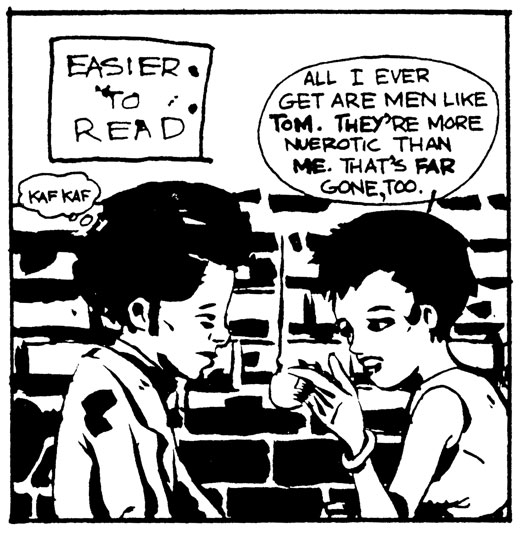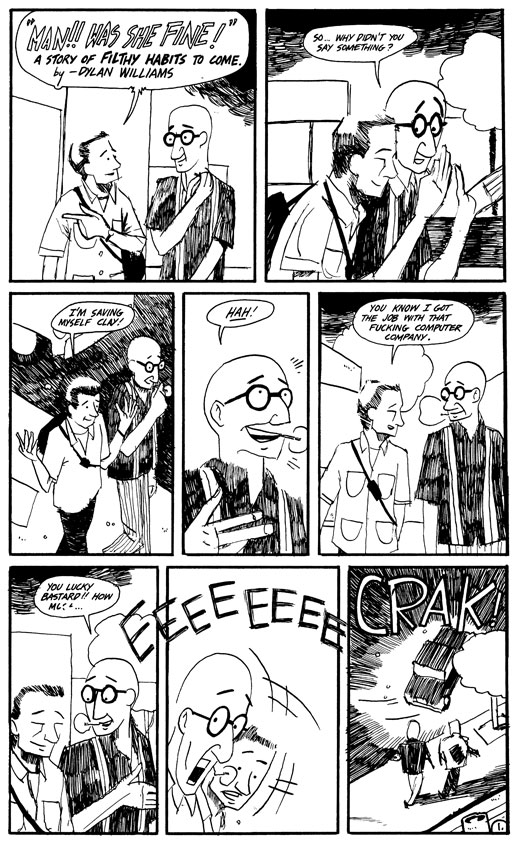 FRED GUARDINEER ON ME
FRED GUARDINEER ON ME
Excerpts from an Interview Conducted by Dylan Williams[NOTE: In April 1999 collector Dylan Williams interviewed Fred Guardineer by phone. Guardineer currently lives in Northern California. The interview was originally edited by Emily Nilsson. A/E plans to print this very long interview in something like its entirety in a near-Future edition; but for the purposes of this issue we have included and edited only those parts of it that deal with Magazine Enterprises and related matters. Even much of Guardineer's relationship with Vin Sullivan, since it occurred at DC Comics, will be covered in the later version.]DYLAN WILLIAMS: What kind of stuff did you draw as a kid?
FRED GUARDINEER: I loved to draw. From the earliest beginnings, before I could do anything else, I drew. My parents gave me a paper bag and a pencil and I lay down on the floor and I drew my brains out. Mostly cowboys and Indians...
[NOTE: Later, after a mention of how much Guardineer liked to draw animals, as well:]
GUARDINEER: I have always gotten into nature. It followed me the rest of my life. I was happiest drawing animals and stuff like that.
DW: I have a Durango Kid where you drew a mountain lion that's just wonderful.
GUARDINEER: Drawings like pistols, rifles, and things like that had to be perfect. I kept a file going on that for years and years and years. No magazine went out of my house that hadn't been clipped and filed. I had files all over the place. I could draw anything in this world. Took about five minutes. I could simply swipe it. It cuts a lot of corners.
DW: Especially when the deadline's down and you've got to get something in!
GUARDINEER: Oh, yeah! It changes your life. I get a call on Friday, they want a job on Monday. You know what you're doing that weekend: You're working.
[NOTE: There follows a long conversation concerning Guardineer's earlier life in and out of comics. Following his service in the Army during World War II, during which he saw action in the Philippines, the talk turned to what he did after the war:]
GUARDINEER: I was getting work. My good friends were back, especially Vin Sullivan, Bob Wood, and Charlie Biro, They were the last ones you'd want to be with you [in a foxhole], but they were good friends of mine to work for. I did a lot of crime comics. I liked the work and I liked them and they paid well.
DW: Jumping ahead a bit - did you know about the Senate hearings [in the 1950s] and problems with crime comics when they came down, or did jobs just dry up all of a sudden?
GUARDINEER: I knew there was a lot of talk, people being upset about comics. Blaming everything that kids did wrong on comics. Like they do today.
DW: Now it's video games!
GUARDINEER: [laughs] Yeah. I knew that was going on. It didn't seem to touch me that much when it first started. Either way, I thought that crime comics were good. It was stories about what happened. It was just like what I like to watch on the TV. I like to watch them today still. My favorite is - there's no way I'm ever going to miss Law and Order.
DW: You like that show, too? It's really authentic, like a modern Dragnet.
GUARDINEER: Yes, I was thinking of Dragnet, too. I was thinking back on the days when I was drawing stuff that was similar: Crime Does Not Pay. Well, something happened. For some reason I had to change and go see my friend Vin Sullivan [at Magazine Enterprises]. I knew the guy and liked him very much. He wanted me to work for him. He was turning out these westerns, The Durango Kid. I did that for about three years. I loved that thing. I don't know what the change was from crime to The Durango Kid, but something was wrong in the business. I knew that - well, maybe Gleason [Lev Gleason, publisher of Crime Does Not Pay] folded.
DW: I have a Durango Kid where you drew Clark Gable as a character in it.
GUARDINEER: I did a lot of work where there were likenesses. I enjoyed that. I would say, probably, the stuff I liked most took me the longest, like westerns, cowboys. That gets bogged down with horses and stagecoaches. You don't just draw stagecoaches - a lot of stuff there. Unless, sometimes, the story concerns backgrounds, bars and things like that where you don't have to draw a lot of horses.
DW: Did you try to make it as authentic as you could?
GUARDINEER: Absolutely! I tried to get the guns and everything. I was knowledgeable about most of that, anyway. I wouldn't try to fool anybody.
DW: Who were your favorite editors to work with?
GUARDINEER: Vin Sullivan.
DW: What was so great about him?
GUARDINEER: [laughs] I just knew him the longest. He was like an old friend. He liked my work and I tried to do my best for him.
DW: Who wrote those Durango Kids?
GUARDINEER: 1 don't know. Somebody did [= drew] Durango Kid ahead of me.
DW: Did you write it yourself?
GUARDINEER: I think I did a couple. You sent me that cover of The Durango Kid and Larry Atwater. I remember doing that.

DW: That's something no one else in comics that I know of would do - put panels on the cover. So who were your favorite writers to work with?
GUARDINEER: I had Gill Fox most of the time. I guess he was a good friend of Vin. Fox was probably knocking out the Durango Kids.
[NOTE: Actually, Guardineer is here confusing artist/editor Gill Fox with Gardner Fox, who had know Vin Sullivan since grade school and who wrote a sizable percentage of the ME scripts, as he had written "Zatara" for Sullivan in the DC years earlier.]
DW: So which comics were your favorites to do?
GUARDINEER: I liked the westerns. I guess the clean good-guy, bad-guy westerns. I liked the crime stuff, too. I guess I liked most everything.
DW: So which western movies did you like?
GUARDINEER: I liked John Wayne, Stagecoach. When they first came on [cable TV], I couldn't get enough of them. I must say, I think I've gotten tired of westerns but I do love those crime things, Law and Order, any time.
DW: What was your favorite stuff of your own comics? What do you think you did the best job on?
GUARDINEER: I think probably The Durango Kid. They were my last shot to, possibly, make a hit. Because I didn't think comics had a good enough stature to plan a life on.
DW: I was going to ask why you quit. That was my next question.
GUARDINEER: Comics had been stop-and-go, ever since they started. It was always like: from one cake of ice to the next, with people folding up and new guys starting. I had made out pretty good. I had paid for everything. I had money in the bank. I wasn't exactly broke, but I didn't see much of a future, especially when Sullivan folded. "Now I gotta go pounding the pavements again," I said. "Not for me!"
I had been in the Army. I had about three years of government service, which is what the Army time would count. So I decided, "I'm gonna get a government job." I was about forty then. That'd give me twenty years. The nearest government job in the neighborhood was the Post Office. So I went to the Post Office and told the Postmaster what I'm telling you. He said, "Come in tomorrow." The way it developed, during my twenty years there I was more of an
artist than anything else.
[NOTE: The remainder of this verbal iceberg, of which the foregoing is only the perhaps 5% tip, will be published in a near-future issue of Alter Ego which will be devoted to the work of Fred Guardineer.]







